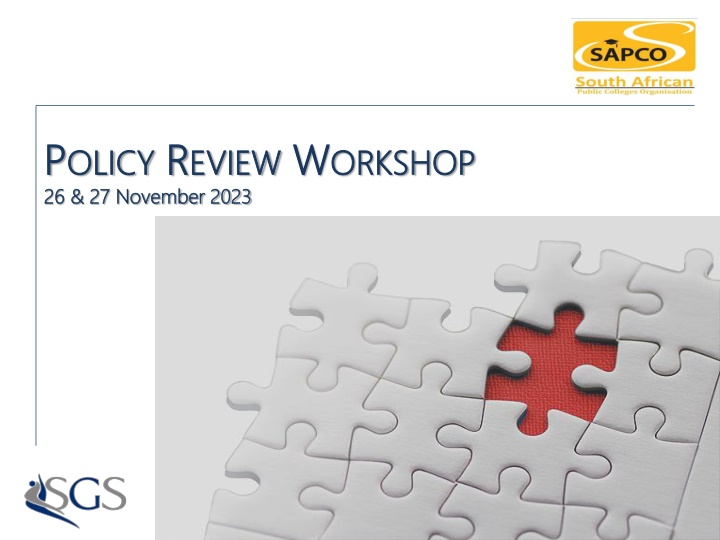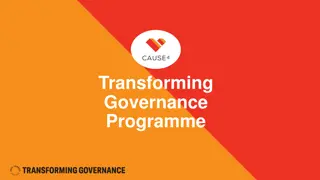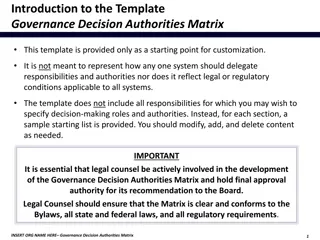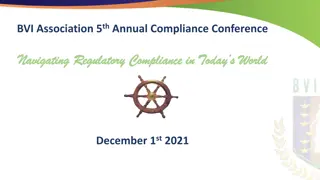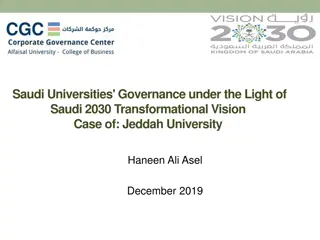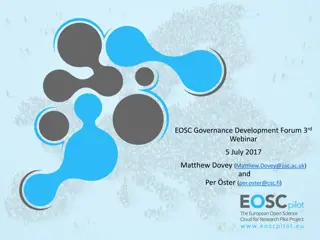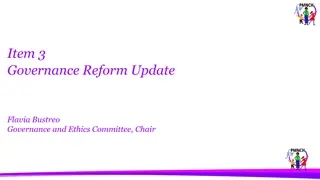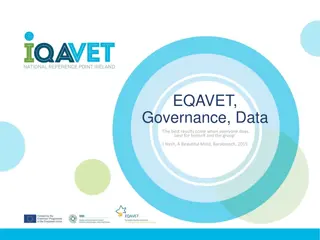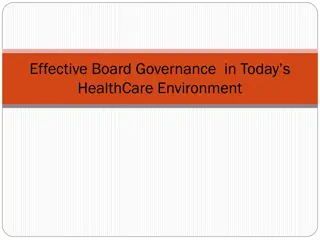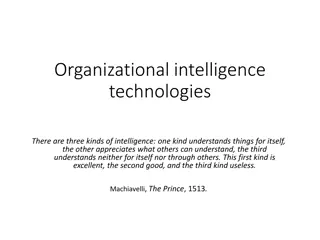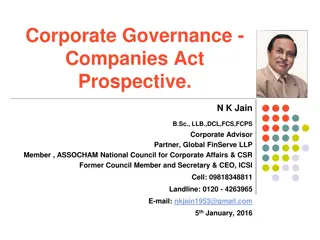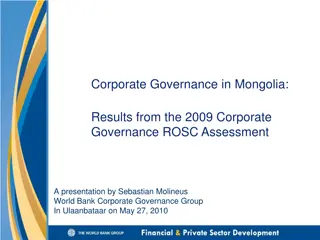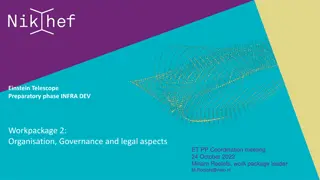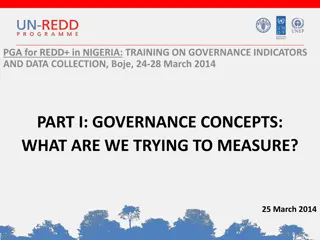Importance of Policies in Organizational Governance
Policies play a crucial role in shaping organizational culture, managing risks, ensuring compliance, and defining values. They set boundaries, provide guidelines, and establish accountability within an organization.
Download Presentation

Please find below an Image/Link to download the presentation.
The content on the website is provided AS IS for your information and personal use only. It may not be sold, licensed, or shared on other websites without obtaining consent from the author.If you encounter any issues during the download, it is possible that the publisher has removed the file from their server.
You are allowed to download the files provided on this website for personal or commercial use, subject to the condition that they are used lawfully. All files are the property of their respective owners.
The content on the website is provided AS IS for your information and personal use only. It may not be sold, licensed, or shared on other websites without obtaining consent from the author.
E N D
Presentation Transcript
P POLICY 26 & 27 26 & 27 November 2023 November 2023 OLICY R REVIEW EVIEW W WORKSHOP ORKSHOP
If we are facing in the right direction, all we have to do is keep on walking. Buddhist saying
WHY POLICIESARE IMPORTANT Policies are rules, principles, guidelines or frameworks that are adopted or designed by an organization to achieve long term goals and define the boundaries for business processes, relationships, systems and individuals. They: articulate the governance culture and structure - without policies there are no written standards about acceptable and unacceptable conduct articulate a culture of risk including risk responsibilities, communication, appetite, tolerance levels, and risk ownership articulate a culture of compliance - what is acceptable and unacceptable starting with legal and regulatory requirements - communicating how the organisation will stay within legal boundaries given the various jurisdictions in which it operates establish the values, ethics, commitments, and social responsibility of the organisation especially when it comes to matters of discretion
WORKSHOP SCOPE Agree consolidated MOI inputs Agree HR and Finance Policy inputs Propose additional policy content Infrastructure Policy SCM Policy Marketing Policy Information & Technology Management Policy Agree the way forward
MEMORANDUM OF INCORPORATION MEMORANDUM OF INCORPORATION AND APPENDICES AND APPENDICES
PROPOSED FORMATTING CHANGES Include cover page with version control Include table of contents Revise numbering, grammar and formatting Remove the names of originators under Art 1 Remove reference to: TVET FET Act SACPO Vice-principal Organisation Constitution Executive Manager and replace with CEO Associates and retain non-voting members (tbc) Faxes Cheques
PROPOSED AMENDMENTSTO DEFINITIONS Board of Directors means the elected office bearers of the Company and the chairpersons of the Provincial Executive Committees CETCollege means a Community Education and Training College as defined in the Continued Education and Training Act No. 16 of 2006, as amended from time to time Chief Executive Officer refers to the salaried employee of the Company who answers directly to the NEC and to whom the whole of the salaried employees of the Company answer no matter the designation/name this person acts under DeputyPrincipal means the person second in command in a public college who assists the principal and may also be a permanent member of staff who is duly appointed to act as the deputy principal. The deputy principal may represent the member college in the absence of the principal GoodStanding refers to the status of a member that has paid all registration and membership fees and met all administrative requirements as prescribed by the NGC from time to time Member means any registered South African Public College in good standing who has been approved by the NGC and includes voting and non-voting members
PROPOSED AMENDMENTSTO DEFINITIONS (CONT.) Non-Voting Members refers to individuals, groups or organisations including CET colleges that support the vision, objectives, values and/or activities of the Company, as well as other role-players, stakeholders or interested parties that identify with the purpose or objectives of the Company, but who do not qualify in terms of the criteria for voting membership. Non-voting members shall be entitled to attend all National General Council meetings of the Company, but shall not qualify to vote in respect of any resolutions to be taken. Likewise, non-voting members shall be restricted to observer status during the NGC Quorum means the minimum number of voting members who must be present for official business to be carried out and in this Memorandum of Incorporate is defined as 50% + 1 of voting members Principal/AccountingOfficer means the chief executive office and accounting officer of a public college and includes a rector of a public college and a deputy principal formally appointed to act in the absence of the principal Proxy refers to a temporary substitute or delegation for the representative of the member college. A proxy cannot stand for election but can cast a vote PublicCollege refers to a public college duly established and registered in terms of the Continuing Education and Training Act No.16 of 2006, as amended from time to time
PROPOSED AMENDMENTS Article 4: Name, Incorporation, Objects and Powers of the Company Changes to the clause of Company Funding as follows: Company funding shall be derived from: (1) its members (2) from an appropriation by the government of the Republic of South Africa in the national, provincial or local sphere (3) from international donors and any other sponsorship Article 5: Membership The following amendments: When a College wants to return as a member after not being a member for a certain time, the College shall pay a registration fee A member not in good standing shall be excluded from participation in Company projects until such time as all outstanding fees have been paid Removal of the ability for non-voting members to serve on any committee subject to the Rules
PROPOSED AMENDMENTS (CONT.) Article 6: Members Meetings - NGC The following amendments or confirmations: The NGC is constituted of all members represented by the principal or acting principal of each member Confirmation of 80% voting support for special resolutions Confirmation of 10% support required for demand for special meeting of the NGC Inclusion of virtual meetings under Location Insertion of a proxy form Article 8 Terms of office for office bearers to be reduced to 2 or 3 years possibly from the next elections Term of office of the provincial chairpersons recommended changed to 4 years (tbc) Recommendation that directors do not get remuneration and are precluded from rendering services Proposal to conduct provincial elections and announce the new provincial chairpersons during the NGC Changed terminology from appointed to elected for provincial chairpersons and office bearers Proposed removal of the secretary general from being a bank account signatory (tbc) Proposed removal of the clauses At least one third of the directors who have served in the province or the NEC for more than 2 (two) years, must resign annually or change the wording to refer to dissolution Proposed removal of the clause Where the authorised Director or Chief Executive Officer has failed to give the required notice of an NEC meeting, or there was a defect in the giving of the notice, such meeting may proceed, provided that all of the members of the NEC: (i) acknowledge actual receipt of the notice (ii) are present at the meeting (iii) waive notice of the meeting
PROPOSED APPENDICES Company Rules (tbc) Alterative Dispute Resolution Dispute Resolution Conciliation Mediation Arbitration Service Providers Severability Code of Conduct for Board of Directors and Member Representatives Professional Behaviour Ethical Behaviour Conflicts of Interest Behaviour and Attitudes Confidentiality Act with Care and Diligence (Fiduciary Responsibility) Dealing with SAPCO Financial Affairs Offering and Accepting Gifts Performance of Duties Attendance of Meetings Director/Member Declaration
PROPOSED APPENDICES (CONT.) Declaration of Interests Protocol Declaration Requirements Interests that shall be Declared Types of Transactions in which Conflicts may Arise Outside Interests Outside Activities Gifts, Gratuities and Entertainment Loans Confidentiality Procedural Guidelines Immediate Disclosure Annual Declarations Possible Outcomes of Declarations Maintenance of the Registers of Interests Compliance Responsibility Any additional appendices
ASPECTSREQUIRING FURTHER DISCUSSION Fees affiliation/membership/registration; due dates and calculation (including whether size of college has relevance) Definition and application of votes of no-confidence Process to follow with colleges that decide not to affiliate to SAPCO then change their decision consideration around affiliation and registration fees or penalties CET status and involvement (incl membership fee payment) COSACSA status and inclusion Possible expansion of clauses on provincial structures Review of the investment clauses and the establishment of a sponsorship register
PROPOSED POLICY REVISIONS PROPOSED POLICY REVISIONS
RECOMMENDED POLICY REVISIONS Inclusion of a control page to manage versions Expansion of the table of contents Reformatting the policy manuals and ensuring the terminology is correct and aligned Inclusion of legislative prescripts Inclusion of guiding principles, procedural guidelines and responsibilities to: provide clear guidelines and principles regarding how things must be done provide clear criteria for decision making provide quantitative thresholds articulate authority and accountability define timing of activities define reporting requirements
HR POLICY MANUAL: CONTENT ENHANCEMENT
RECRUITMENT, SELECTIONAND APPOINTMENT Guiding Principles Publicity and Recruitment Methods of Recruitment Selection Procedural Guidelines Recruitment The Selection Process Establishing the HR Committee Inviting Unions (if applicable) Screening Applications The Appointment Appeals or Disputes Selecting and Assessing
STAFF CODEOF CONDUCT Relationship with the member representatives and Board of Directors Relationship with the Public Relationship among Employees Performance of Duties Personal Conduct and Private Interests Declaration by Employee
PROBATION Justification for Probation Period of Probation Assessment Format Obligations of the Employer Obligations of an Employee on Probation Performance Improvement Plan Fairness and Justifiability Communication of Shortcomings Termination of Probation
SEPARATIONFROM SERVICEAND STAFF EXIT MANAGEMENT Types of Terminations Ill Health Termination Retirement Death Dismissal through the Conduct of an Employee Procedural Guidelines Resignation Retrenchment Ill Health Retirement Death Imprisonment Misconduct Abscondment Non-renewal of Contract Certificate of Service
LEAVE MANAGEMENT Annual Vacation Leave Special Leave in Extraordinary Circumstances and Quarantine Purposes Arrest, Imprisonment or Appearance in a Court of Law Family Responsibility Leave and Special Leave for Urgent Private Affairs Normal Sick Leave Temporary and Permanent Incapacity/Disability Leave Use of Annual Leave for the Treatment of Substance Abuse Leave for Occupational Injuries and Diseases Maternity Leave and Adoption and Surrogacy Leave Leave for Office Bearers or Shop Stewards of Recognised Employee Organisations (if applicable) Study Leave Special Leave for Professional and Personal Development and for Religious Observances Attendance of Classes during Office Hours Special Leave for Examination Purposes Managing Absenteeism Desertion Procedure
MANAGEMENTOF CONDUCTANDTHE DISCIPLINARY CODE General Principles Codes, Rules and Standards Procedural Guidelines Disciplinary Actions Corrective Counselling Verbal Warnings Written Warnings Final Written Warnings Serious Misconduct: Disciplinary Hearing Notice of Enquiry Precautionary Suspension Conducting the Disciplinary Hearing Sanctions Appeal The Process The Appeal Authority
PERFORMANCE MANAGEMENTAND APPRAISAL The Performance Management and Development Cycle Procedural Guidelines Performance Planning Performance Monitoring Performance Review and Assessment Categories of Performance Factors Achievement of Key Result Areas Conduct Criteria Biannual Performance Reviews Preparing for the Formal Performance Review and Performance Assessment Support Two-way Feedback Continuous Learning and Development Annual (End Of Cycle) Performance Assessment Pay Progression, Rewards and Other Non-financial Decisions on Key Career Incidents Non-Financial Rewards Performance Awards (Cash Bonuses) Performance Categories Linking the Final Assessment Score to Specific Consequences Corrective Measures for dealing with Performance not Fully Effective Appeals Moderating Arrangements First Level of Moderating Second Level of Moderating Third Level of Moderating
MANAGEMENTOF GRIEVANCES General Principles Adherence to Time Limits Provision of Information Procedural Guidelines First Level Authority Second Level Authority Third Level Authority Guideline For Groups Of Employees
STAFF INDUCTION & STAFF DEVELOPMENT Staff Induction Levels of Induction Duration of Induction Check in Meetings at 3 And 6 Months Compulsory Induction Programme Induction Programme Checklist and Evaluation Staff Development Needs Assessment Workplace Skills Plans Personal Development Plans Development Selection Reporting
EMPLOYEE WELLNESS Guiding Principles Scope and Focus of the Programme Services and Eligibility Counselling and Advisory Services Trauma Response Services Training Principles of Employee Health and Wellness (Confidentiality, Accessibility, Neutrality, Voluntary Participation and Free from Stagmatisation) Stakeholders of the Programme Prevention of Programme Abuse Leave Procedural Guidelines Referral Steps Identification of Staff Needing Assistance Confrontation Record Keeping Referral and Evaluation of Progress Referral Procedures Means of Referral Formal Referral and Self-Referral Sessions Required and Payment for Services Record Keeping and Implementation Follow-up and Monitoring Reporting Time Off Work and Leave Requirements
HARASSMENTAND HIV/AIDS HIV/AIDS Non-discrimination and Equality with regard to Employees With HIV/AIDS HIV/AIDS Testing and the Appointment of Employees Disclosure of HIV/AIDS-related Information and Confidentiality Refusal to Work with an Employee with HIV/AIDS Procedural Guidelines Implementation of Universal Precautions Medical Support Implementation of Adequate Barriers Other Procedural Guidelines Sexual Harassment Forms of Sexual Harassment Types of Conduct That May Be Construed As Sexual Harassment Employees Rights and Responsibilities Procedural Guidelines Lodging a Sexual Harassment Complaint Informal Procedure Formal Procedure Criminal Charges and/or Civil Claims Confidentiality Leave of Absence Monitoring and Evaluation Dispute Resolution
FINANCE POLICY MANUAL: CONTENT ENHANCEMENT
ADMINISTRATION, MANAGEMENTAND CONTROLOFTHE BUDGET Delegations of Authority Approval of Electronic Payments Appointment of Budget Managers Budget Requirements Budget Process Phase 1: Budget Preparation Phase 2: Budget Compilation Phase 3: Budget Approval and Allocation Phase 4: Budget Control Management Reporting Monthly Annually
ADMINISTRATIONAND MANAGEMENTOF INCOMEAND INVESTMENTS Sources of Income Collection of Income Income Budget Investments Limiting Exposure Risk And Return Payment Of Commission Call Deposits and Fixed Deposits Restriction on Tenure Of Investments Control over Investments Other External Investments Investments for the Redemption of Long-term Liabilities Interest on Investments Management Reporting
INSTITUTIONAL CASHFLOWAND CASH RESOURCES Sources of Funding Investing Surplus Funds Working Capital and Liquidity Management Cash Flow Forecasting Payments to Creditors Management of Inventory Cash Management Programme Banking Arrangements Opening Bank Accounts Primary Bank Account Control of Bank Accounts Withdrawals from Bank Accounts Management Reporting
DEBTORS, DEBT RECOVERYAND WRITE- OFFOF IRRECOVERABLE DEBT Compliance with the National Credit Act Classification of Debt (Current or Overdue) Debt Impairment Incidental Credit Agreements Administration of Staff Debt Administration of Member Debt General Debt Management Process Guidelines Debt Handover Process Legal Services Bad Debt Provision and Write-off Of Debts Reporting
FINANCIAL REPORTING The Preparation of Annual Financial Statements Underlying Assumptions Fair Presentation Comparatives Procedural Guidelines Month End and Year-end Procedures Procedures for Monthly Budget Reporting and Monitoring Procedures for Annual Reporting and Monitoring Cashflow Reporting Preparing the Financial Statements
CREDITOR MANAGEMENTAND ACCOUNTING RECORD CONTROL Creditor Management Payment Guidelines Payment Processing Reporting Accounting Records Safeguarding and Control Availability of Financial Information Safe Custody Destruction of Records
GIFTS, DONATIONSAND SPONSORSHIPS Granting of Gifts, Donations and Sponsorships Acceptance of Gifts, Donations and Sponsorships Internal Controls over Gifts, Donations and Sponsorships Granting of Gifts, Donations and Sponsorships of Moveable Assets or Cash Acceptance of Gifts, Donations and Sponsorships by the Organisation Gifts or Donations of Immovable Property Gifts and Donations received by Employees Management Reporting
